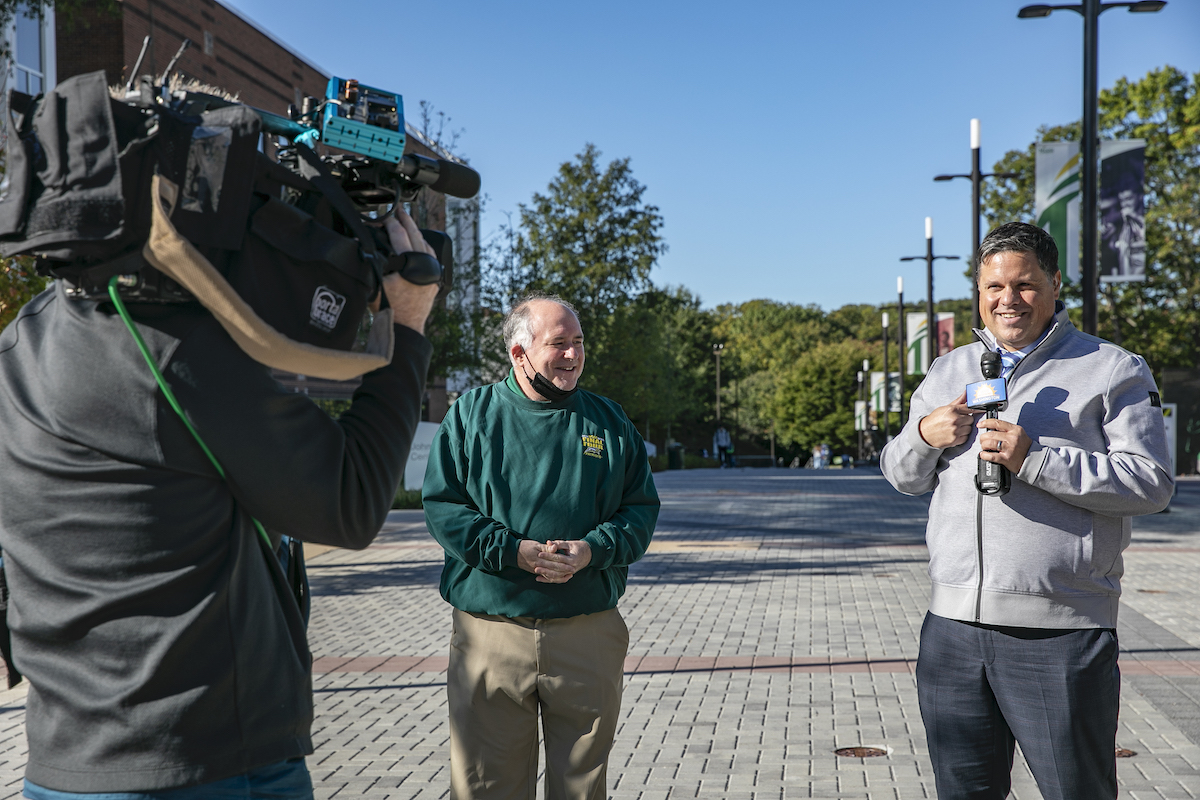
Does it take natural abilities to communicate to the public? That was one question George Mason University students posed to meteorologist and media personality Brian van de Graaff.
Van de Graaff, who graduated from Mason with a BA in speech communication in 1997, was recently invited to talk to students in Rodger Smith’s COMM 359 Media Management class in the College of Humanities and Social Sciences.
“Brian has great pride in his profession,” said Smith, a Department of Communication professor and faculty advisor for WGMU, Mason’s online radio station. “He could express that to a set of students who realize what they could aspire to in communication.”
Van de Graaff has been a member of the StormWatch7 Team on the Washington, D.C., area’s ABC television affiliate for more than 20 years. He also carries the American Meteorological Society’s Seal of Approval, in recognition for sound delivery of weather information to the general public.
“Bringing in guest speakers from the professional world adds to my curriculum,” Smith said. “Their experiences add to a student’s education and offer information to support or add to what is in their textbooks.”

“I love how Professor Smith gives us real-life examples of people in the business and have them give us lectures,” said Alejandro Hernandez Pichardo, a senior majoring in communication with a minor in media production and criticism. “This really inspires me to be better and believe that I can achieve anything I want.”
Van de Graaff noted that working in media and television can be a little bit of a stressful business, so flexibility and having the ability to think on your feet are important in this industry.
He said one thing that has changed in the field is now there’s more time dedicated within an eight-hour day to duties beyond preparing and delivering the on-camera weather forecast, such as updating the website, push alerts, and the news ticker—a horizontal or vertical text-based display that typically resides in the lower section of the screen space during news programming.
“I was thrilled to hear about the diversity of the business,” Pichardo said. “You’re not doing the same thing every day, and there are so many opportunities.”
Van de Graaff noted that those interested in building career momentum need to get accustomed with relocating, as television contracts can be changed, and re-assigned. “People go from city to city, and it can be hard to put down roots.”
He previously forecasted the weekday morning and midday weather, with his first assignment on ABC7’s Good Morning Washington. Van de Graaf shared how his on-air career path took him from Salisbury, Maryland, to Richmond, Virginia, to New York City and back home to Washington, D.C.
Van de Graaff added that smaller markets are a great place to learn how things work and flow on local news programs. “The smaller stations allow you to grow into your roles,” he said.
“My biggest takeaway was how Van de Graaff was able to work in multiple markets from small to large in order to get the experience needed for the job,” said Pichardo.
Van de Graaff also shared a blooper reel with the students, a video segment showing three images of the meteorologist on the television screen at the same time, as if he had been cloned. Van de Graaff said these sorts of mishaps can be daunting, but you have to be flexible.
Kyla Lapaige Hayes, a junior communication major with a concentration in media production and criticism, asked Van de Graaff whether it takes natural abilities to communicate to the public.
“It was inspiring to know that even someone who had done that for many years can admit that nervousness is common and can be solved with practice over time,” Hayes said.
Van de Graaff also explained the process of putting together a package, predicting the weather, and the preparation involved for his weather segment. The latest trend is to incorporate lifestyle-driven graphics into the forecast—whether it be going to a daytime outdoor event or out to dinner.
As an undergraduate at Mason, Van de Graaff said he worked at WGMU and shadowed local DC broadcast legends at WUSA, Channel 9, for a video project. He was also a Mason Ambassador and enjoyed giving tours to prospective students.
“I am forever grateful for the opportunities that Mason provided me, and I'm eager to give back in any way I can,” said Van de Graaff. “I hope that speaking with the students about my journey into a career in communication may help inspire or motivate them as they navigate their way.”
